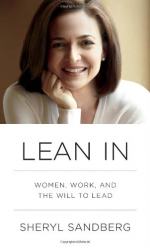
|
| Name: _________________________ | Period: ___________________ |
This test consists of 5 multiple choice questions, 5 short answer questions, and 10 short essay questions.
Multiple Choice Questions
1. What was the author voted as by her senior class, according to the narrative in Chapter 3: “Success and Likeability”?
(a) “Most likely to be a politician.”
(b) “Most likely to become famous.”
(c) “Most likely to end up in jail.”
(d) “Most likely to succeed.”
2. The author notes in Chapter 4: “It’s a Jungle Gym, Not a Ladder” that “an internal report at Hewlett-Packard revealed that women only apply for open jobs if they think they meet” what percent of the criteria listed?
(a) 90%.
(b) 100%.
(c) 80%.
(d) 60%.
3. How old does the author say Mark Zuckerberg was when she graduated college in Chapter 4: “It’s a Jungle Gym, Not a Ladder”?
(a) 3.
(b) 15.
(c) 7.
(d) 12.
4. What speaker from the Wellesley Centers for Women gave a talk called “Feeling Like a Fraud” when the author was inducted into the Phi Beta Kappa honor society?
(a) Clara Shih.
(b) Omid Kordestani.
(c) Dr. Peggy McIntosh.
(d) Mary Sue Coleman.
5. Who is described in Chapter 3: “Success and Likeability” as one of the engineering directors at Facebook who held a meeting in 2011 with female engineers to encourage them to share the progress they’d made on products they were building?
(a) Jocelyn Goldfein.
(b) Judith Rodin.
(c) Virginia Rometty.
(d) Cameron Anderson.
Short Answer Questions
1. In 2010, women were paid how much for every dollar that their male counterparts were paid, according to the author in the Introduction: “Internalizing the Revolution”?
2. According to the author in Chapter 1: “The Leadership Ambition Gap,” females make up what percentage of people earning undergraduate degrees today?
3. Where does the author say she attended a large public high school growing up in Chapter 2: “Sit at the Table”?
4. Who is the New York University professor that co-ran an experiment to test perceptions of women and men in the workplace in the 2003 study discussed in Chapter 3: “Success and Likeability”?
5. The author says in Chapter 2: “Sit at the Table” that while in college, both she and her brother took a course in what together?
Short Essay Questions
1. How is “stereotype threat” defined in Chapter 1: “The Leadership Ambition Gap”?
2. What does the author say of Padmasree Warrior in Chapter 2: “Sit at the Table”?
3. What story does the author use to connect the title of Chapter 5: “Are You My Mentor?” with the theme of the chapter?
4. What did Sandberg’s experience during her first pregnancy teach her about gender equality in the workplace in the Introduction: “Internalizing the Revolution”?
5. What study does the author describe in the beginning of Chapter 3: “Success and Likeability”? Who conducted the study?
6. How does the author describe the disparity between the treatment of male and female behaviors at a young age in Chapter 1: “The Leadership Ambition Gap”?
7. What author from The New Yorker is cited in Chapter 3: “Success and Likeability”? What did this author say about self-doubt?
8. How does the author propose overcoming “impostor syndrome” in Chapter 2: “Sit at the Table”?
9. How does the author describe Peggy McIntosh’s impressions on her in Chapter 2: “Sit at the Table”?
10. What story is related of Josh Steiner in Chapter 5: “Are You My Mentor?”
|
This section contains 975 words (approx. 4 pages at 300 words per page) |

|




